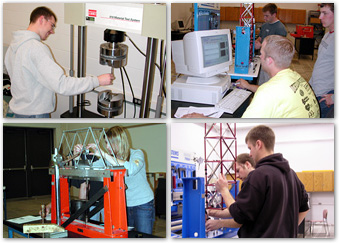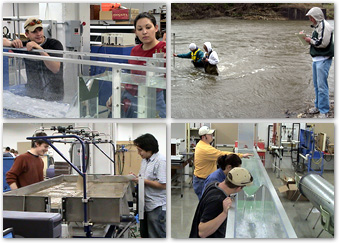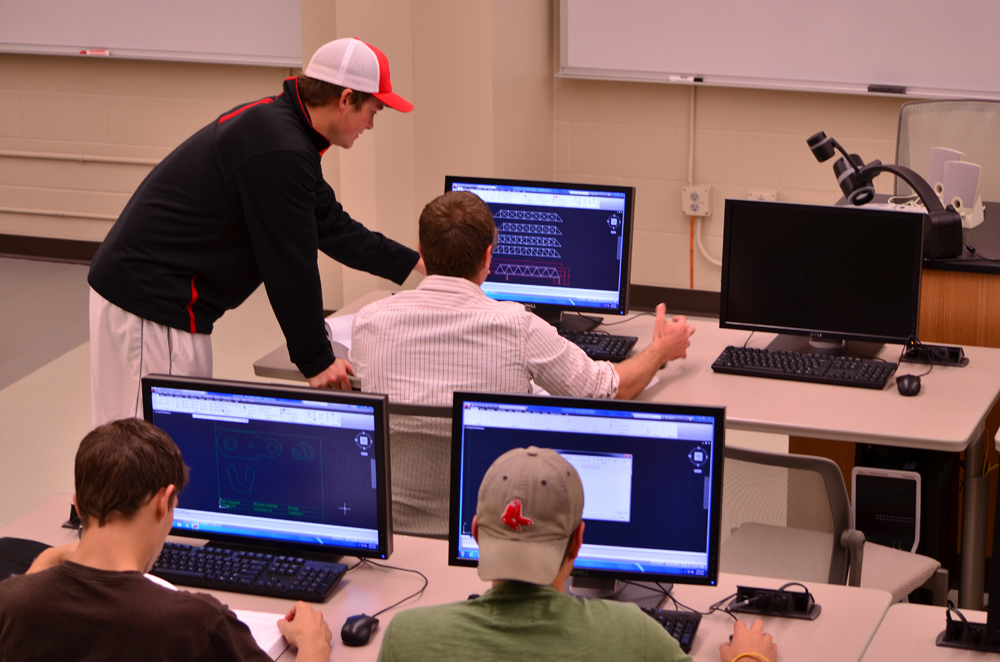Civil Engineering Labs
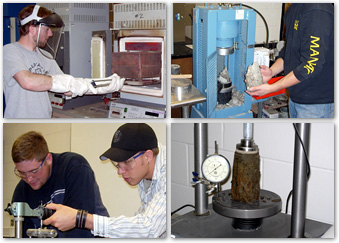
Construction Materials Testing Lab
This 1400 sq. ft. laboratory was constructed in 2007, increasing the lab floor space by a factor of more than three compared to the previous location.
Construction Materials Testing Lab CollapseThe lab contains several testing stations allowing for up to four student groups each, used for materials testing by students in the Civil Engineering Experimentation I (CIVE 435) and Properties of Concrete (CIVE 432) courses as well as for demonstrations in the Introduction to Civil Engineering (CIVE 101), and occasional discussions and demonstrations in the Fundamentals of Pavement Design (CIVE 461) and Geotechnical Engineering courses (CIVE 360). Test stations in the laboratory include the following.
Testing Capabilities
- 55-kip MTS universal testing machine which is used to conduct a wide range of materials tests such as elastic modulus and poissons ratio of concrete and resilient modulus and triaxial strength of soils.
- 250-kip Forney compression machine to measure the strength of materials such as concrete in compression, flexure, and indirect tension.
- Constant strain load frame for unconfined compression, triaxial loading, and California Bearing Ratio testing,
- Materials mixing station which is primarily used for mixing concrete, but is also used for preparing stabilized soils, and can be used for preparing hot mix asphalt concrete samples. There is also equipment for conducting fresh concrete tests such as slump, unit weight, and for preparing samples for later testing.
- Specific gravity bench for determining specific gravity of coarse and fine aggregates, and for maximum and bulk specific gravities of asphalt mixtures.
- Environmental chamber (in the structures laboratory, but used by the materials lab). The chamber can create climatic conditions from 5 to 100 C and from about 30% to almost 100% humidity. It is used primarily for curing concrete samples and is occasionally made available to other departments.
- Alkali-Silica Reaction station to teach about the potential problems of materials incompatibility in concrete.
Properties of Metallic Materials
Objectives
- To acquaint the students with the stress-strain behavior of selected materials.
- To familiarize the students with the procedures of performing uniaxial tests.
- To familiarize the students with non-destructive testing.
Structural Deflection
Objectives
- To familiarize the students with the principles involved in structure testing.
- To analyze the structural deflection due to a point load using energy methods.
Structural Frame Analysis
Objectives
- To familiarize the students with the principle involved in structural frame testing.
- To analyze the structural response due to applied loads on a frame.
Environmental Lab
Discover What Minnesota State Mankato Civil Engineering Offers Environmental and Water Resources
Environemental Lab CollapseAnalysis in support of strategic evaluations, designs, public outreach and development of best management practices (BMPs)
- Evaluation of sediment source, transport and trapping for improvement of surface water quality
- Treatment of water for sediment control through filtration, sedimentation and flocculation
- Documentation and design of Best Management Practices (BMPs) to encourage construction and land management activities integrated with high quality environmental actions
- Delineation of activities related to construction and land management - Sediment characterization and Gravimetric, filtration, and chemical evaluation of sediments
- Creation of design guides
- Development of training and implementation processes
- Assistance with public outreach
Testing Capabilities
- Water Analyses
- Turbidity
- pH
- Conductivity
- Total Suspended Solids
- Total Dissolved Solids
- Biological Oxygen Demand
- Carbonaceous Oxygen Demand
- Organic Content Phosphorous
- Nitrate / Nitrite / Ammonia
- Chlorine / Chloride
- Iron
- Copper
- Manganese
- Alkalinity
- Soil and Sediment Analyses
- Grain Size Analysis
- Hydrometer Analysis
- Plasticity Index
- Compressive Strength
- Shear Strength
- Photomicroscopy
- Shape Determination
- Watershed / Waterway Analyses
- Infiltration Analysis
- Runoff Coefficient Evaluation
- Flow Measurement - Surface Water
- Flow Measurement - Ground Water
- Chemical Nature & Extent
- Chemical Fate & Transport
- Reactor Mechanics Evaluation
- Reactor Hydraulic Retention Time Analysis
- Culvert Analysis
Fluid Mechanics Experiments
Students will determine the effect of hydrostatic forces acting on submerged surfaces. The hydrostatic force and center of pressure will be experimentally determined and compared to theory.
Fluid Momentum Balance
Students will become familiar with the measurement of forces developed by fluids in motion. The force produced by a water jet striking a stationary vane will be determined and compared to predictions from fluid mechanics theory.
Pressure Measurement
Students will become acquainted with techniques for the measurement of pressure, including the basic pressure-height relation. A dead weight tester will be used for gage calibration and to examine linearity and hysteresis effects.
Flow Rate Measurement
Students will become familiar with techniques used in the measurement of fluid flow rate. Proper calibration of a rotameter and the calculations necessary for a Venturi, flow nozzle, and orifice plate will be determined.
Head Loss in Piping Systems
Student will become familiar with the measurement of head loss in piping systems. The friction factor for various pipes and the loss coefficients for fittings and valves will be determined.
Centrifugal Pump
Students will study the performance of a centrifugal pump. They will become acquainted with pump characteristics such as head, net positive suction head, and brake horsepower, and how they change with flow rate.
Hydraulics and Hydrology Experiments
Open Channel Flow Measurement
Students will study flow in an open channel. Flow rates will be determined using various weirs and spillways and compared to flow rates determined from Venturi meter measurements. Open channel flow phenomena such as hydraulic jumps will be demonstrated.
Rainfall-Runoff Relationships for a Basin
Students will become familiar with rainfall-runoff relationships and how various basin conditions and rainfall patterns affect the runoff hydrograph. Students will measure runoff hydrographs for various rainfall patterns and basin conditions and determine the corresponding runoff/rainfall ratio
Streamflow Measurement
Students will take a field trip to a local stream and use a handheld flow meter to record river velocities at various locations along a cross-section. River discharge will be determined using these measurements and compared with real-time USGS stream gage data.
The Civil Engineering CAD Lab is equipped with high performance workstations loaded with professional software including AutoDESK Civil 3D, ArcGIS, HydroCAD, and many other software packages that you will use in the real world. The lab also has a large format plotter for plotting projects and coursework.
Engineering Projects Lab
This engineering workshop is a well-equipped machining and fabrication facility which provides a service to the faculty and students of engineering programs.
Engineering Projects Lab CollapseFacilities include lathes, horizontal and vertical milling machines, drills, grinders, saws, shapers, planers, electric and oxy welding, a CNC milling and turning centers, and a multi-axis robot for welding. Manufacture and repair of a wide variety of equipment is undertaken for research, teaching, and general University purposes.
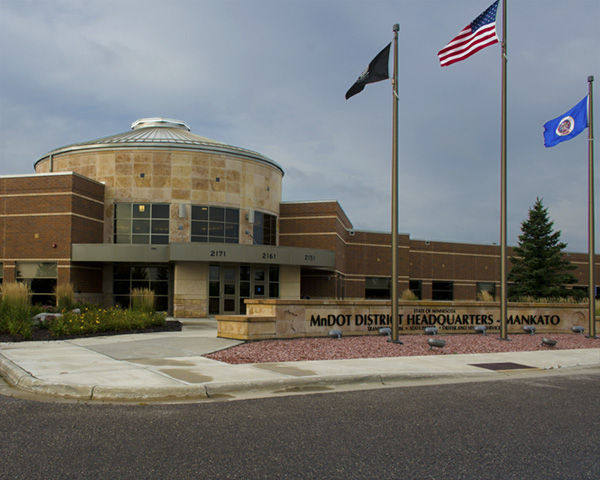
MN DOT Materials Lab
The faculty in the civil engineering program have developed a strong relationship with the District 7 office of the Minnesota Department of Transportation, including their laboratory staff, and materials, design, and construction engineers.
MN DOT Materials Lab CollapseMSU civil engineering students in the experimentation class (CIVE 436) use, and are shown demonstrations of, the District's advanced asphalt concrete testing equipment for a portion of their coursework.
The equipment includes the Superpave gyratory compactor, maximum and bulk specific gravity, asphalt cement content by solvent extraction and by ignition, and other Superpave required tests including fine aggregate angularity, flat and elongated particles, and sand equivalent. The District 7 materials lab staff also discusses their AMRL certification and the strict testing standards and heavy work load required of a busy laboratory. As a result of their AMRL accreditation, they maintain their equipment in excellent condition.

